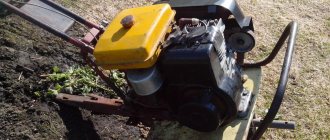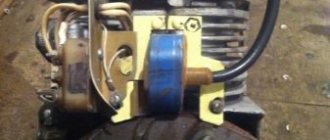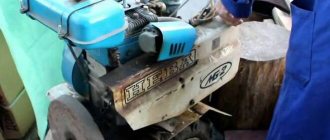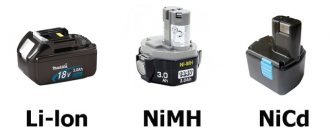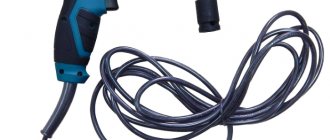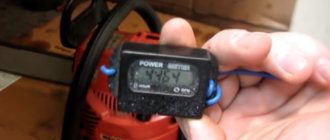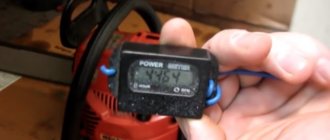When your hitherto trouble-free walk-behind tractor begins to act up, it is very annoying. It’s doubly annoying when this happens in a situation where there’s a lot of work and without a walk-behind tractor, it’s like without hands. It seems to start normally, but as soon as you give it a load, it immediately sneezes and stalls. What is the reason for such “betrayal”?
Why does the walk-behind tractor stall under load?
A fairly common problem is that the equipment stalls after 5 minutes of operation. Often the reason is a fuel supply failure and ignition problems. If the equipment stalls during operation, you need to check how well the fuel is supplied:
- The candle is taken out and examined. It is overdried - this indicates a lack of fuel;
- There must be enough fuel in the gas tank for the normal functioning of the machine;
- The condition of the fuel valve is inspected. It may simply be blocked. Sometimes it is enough to open it for further use of the unit.
The walk-behind tractor starts and stalls if there is a problem with the ignition. First you need to check the spark plugs. Wet elements indicate breakdown. It is necessary to re-adjust the ignition system of the equipment.
Resetting is done as follows:
- The cover is removed, which protects the parts of the ignition system;
- The engine flywheel rotates until the contacts in the magneto open;
- A special feeler gauge measures the gap from the “anvil” to the “hammer”;
- The flywheel rotates until the piston is compressed. The latter must reach its peak;
- The flywheel turns again until a characteristic knocking sound is heard, which will indicate the operation of the overrunning clutch;
- The flywheel turns in the other direction until the mark of this element coincides with the mark on the body of the unit;
- The gap from the interrupting contact to the cam is set to 0.3 millimeters;
- The cam is fixed with a screw, which is located above the element, and a protective cover is installed in the equipment body.
If the above steps are performed correctly, the walk-behind tractor will not stall under load. When tilted, equipment may stall if there is not enough fuel in the gas tank. The unit must be installed straight and the starter cable removed. If the engine starts, you need to fill the tank with fuel.
Causes of breakdowns
There are a large number of different reasons why a motor fails. Repair of motor cultivators can be carried out at the following points:
- Unstable work.
- The silencer fires.
- The engine stalls under load.
- The engine stalls when starting.
In Moscow there are a large number of companies that repair equipment. Services can be expensive, so many people do the work themselves.
Why does it stall under load?
In most cases, the engine stalls under load due to problems in the fuel supply and ignition system. Fuel system faults can be checked as follows:
- The spark plugs are unscrewed for visual inspection. If the working part is too dry, then there is a possibility of insufficient fuel in the system.
- If the fuel level in the gas tank is too low, shaking may prevent fuel from flowing into the engine.
- The technical condition of the fuel tap is inspected. In some cases, it may be slightly blocked and the engine stalls due to insufficient fuel supply.
The engine of a walk-behind tractor may stall due to incorrect settings of the ignition system.
Too high humidity on the surface of the spark plug indicates a malfunction of the entire fuel system.
Re-tuning is carried out according to the following algorithm:
- The cover is removed, which protects the main parts of the system.
- The flywheel rotates until the contacts open.
- A special probe is used to check the resulting gap.
- The flywheel rotates until the piston is fully compressed. The load is applied until the characteristic sound of the overrunning clutch appears.
- The flywheel is turned in the opposite direction until the marks coincide.
- The gap from the interrupting contact to the cam is set to 0.3 mm.
- The cam position is fixed.
The above procedure solves the problem of the situation where the engine stalls when a load is applied.
Why does it work intermittently?
The installed engine may operate intermittently. The reasons are as follows:
- Using bad fuel. Long-term operation with such a problem may cause a malfunction.
- The equipment operates jerkily if the engine is not fully warmed up. The solution to the problem is to stop the procedure, after which the structure should cool down, the walk-behind tractor turns on and warms up at idle for several minutes.
- The engine may not pull over if the filter elements are clogged.
In some cases, the cable is adjusted to change the amount of fuel supplied to the internal combustion engine.
Why does it shoot at the silencer?
Many problems arise when a silencer fires. A problem can only be solved if it is precisely defined. The silencer fires in the following cases:
- Too much oil in the fuel.
- The ignition is set incorrectly.
- The fuel is of poor quality and does not burn completely in the cylinder block.
Repair problems can only arise if the fuel does not burn completely.
Why does it start and stall?
The walk-behind tractor can start and stall almost immediately. The problem is that the ignition is set incorrectly; to solve it, the spark plug is cleaned and the wiring integrity is checked.
An important element of the fuel system is the carburetor, which mixes fuel with air in the required proportions. Its clogging can cause improper operation; repair involves disassembly and thorough cleaning. Insufficient revolutions indicate a lack of gasoline.
Some models of cultivators do not develop speed if the gearbox breaks down. This is indicated by extraneous sounds emanating from the installed gearbox. The malfunction is eliminated by replacing the oil and worn elements.
Why does the walk-behind tractor work intermittently?
There are other faults that are worth considering:
- The walk-behind tractor engine is running backwards. The reason is often the use of bad fuel. It will not be enough to replace the fuel. The pump and fuel supply hoses are washed;
- The equipment works in jerks. The engine does not warm up completely. You need to turn off the engine and wait for it to cool completely. Then restart it and warm it up for at least ten minutes;
- The engine does not pull, therefore the engine power decreases. The filter system is checked and cleaned. The problem can be caused by wear of the ignition magneto. In this case, the part is replaced.
Owners of both gasoline and diesel vehicles may encounter such problems. Regardless of the specifics of the breakdown, you must urgently stop using the unit and start fixing the problem.
Why does the walk-behind tractor shoot into the muffler?
Sometimes the operation of equipment is accompanied by unusual sounds from the muffler.
The walk-behind tractor smokes and stalls. To eliminate such a malfunction, it is necessary to first determine what caused it. Such problems may occur in the following cases:
- Excess motor oil in fuel. The remaining fuel is drained, the fuel pump and hose system are washed, and new fuel is added;
- Incorrectly set ignition. It is necessary to check how correctly the gap between the electrodes is set;
- The fuel in the engine cylinder does not burn completely. In this case, it is necessary to disassemble the piston system, thoroughly wash and dry the cylinder, and adjust the carburetor.
In the above cases, it is not difficult to repair walk-behind tractors yourself. It is important to strictly adhere to the algorithm of actions.
Why does the walk-behind tractor start and stall?
If the equipment starts and immediately stalls, this may indicate the following problems:
- There may be a large distance between the electrodes, problems with contacts in the electronics, or the spark plug may be dirty. First, the candle is cleaned. Then the integrity of the wires is checked. The normal distance between the electrodes is set;
- The carburetor may become dirty, too little fuel is supplied. Sometimes it is necessary to change the fuel and reduce the amount of oil. The carburetor is dismantled, disassembled and thoroughly cleaned;
- If the unit does not pick up speed, this indicates a lack of fuel. Gasoline may simply spill. The defect must be eliminated or the fuel tank replaced;
- The walk-behind tractor does not develop speed when the gearbox breaks down. This is indicated by the presence of extraneous sound from the gearbox. The malfunction can be eliminated by replacing the oil that lubricates the components.
Why does a walk-behind tractor engine have difficulty starting when hot?
The equipment may stall when heated.
This problem can be resolved relatively easily. This is often caused by excess air being supplied to the carburetor. It is mixed with gasoline and motor oil and acts as a carburetor coolant. So the temperature of the latter is much lower than the temperature of the walk-behind tractor engine. To fix the problem, you need to follow a certain algorithm. It is important to start the engine. To do this, perform the following steps:
- When starting the engine, the throttle trigger is squeezed halfway;
- You should not regularly press the gas trigger, as this may cause the engine to flood;
- After starting the engine with the throttle trigger pressed halfway, you need to throttle it thoroughly. Afterwards you can continue working.
Simple actions will prevent an increase in the load on a heated engine; the main elements and systems are not subject to increased wear. The listed methods will allow you to eliminate any malfunctions with the unit. They are equally effective for owners of the following brands: Agro, Honda, Neva, Cascade.
The walk-behind tractor starts and stalls, does not develop speed, malfunctions, repairs
The “heart” of any gasoline-powered vehicle is the engine. Walk-behind tractors are no exception to this. Their motor part creates a working stroke, power potential, and declared productivity, which together make it possible to perform certain agricultural operations.
But often it is this working node that is the most vulnerable. Low-quality fuel, severe overloads, lack of regular diagnostics and many other reasons cause serious malfunctions, the timely detection and repair of which will determine its further performance. This article will be devoted to what types of breakdowns are most often characteristic of walk-behind tractor engines, and which ones can be diagnosed and fixed at home.
The starter squeals, the cord comes out
The cultivator made several pops, the speed began to “float”
The material will be updated, we are waiting for comments with questions, stories about identifying a particular malfunction and ways to eliminate it. Also, see the answers to questions about a particular walk-behind tractor model on its description page.
Sources:
https://garden-shop.ru/ne-zavoditsya-motoblok-prichiny-kak-zavesti.html https://pro-motobloki.ru/remont-motobloka-svoimi-rukami/219-neispravnosti-motobloka.html
The walk-behind tractor starts and stalls: causes of malfunction and mechanisms for eliminating them
Owners of either brand new or used motor cultivators are not insured against a situation where the walk-behind tractor starts but immediately stalls at idle.
It can be caused by a number of factors:
- problems in the ignition system:
- loose or broken electrical contacts;
- spark plug malfunction. They can be installed only after unscrewing and external inspection. If the candle:
- dry - the cause of the malfunction lies in the carburetor, where gasoline is not supplied. It may occur due to clogging of its filter or a separate jet;
- wet - the engine does not develop speed due to an excess of fuel;
- covered with soot - the fact of its failure, which may result in the failure of an ignition spark to form. Testing with electrodes will help you finally verify this;
- after replacing or cleaning the spark plug, the electronics are examined - the integrity of the connections and the wires themselves, which may need repair due to strong vibration;
- shortage or poor quality of fuel . Often the engine does not gain speed due to an incorrectly prepared fuel mixture or debris in the carburetor. In this case, the repair begins with removing it from the walk-behind tractor body and cleaning it from dirt particles. At the same time, they change the fuel, after draining the old one and washing the fuel tank and supply hoses.
- Another reason that the walk-behind tractor starts up and immediately stalls, related to gasoline, may be depressurization of the gas tank itself. Very often this is observed after a long period of inactivity (for example, after winter), when the walk-behind tractor has not been used for a long time and has been stored with gross violations. After repairing or replacing the entire fuel tank, the functionality of the device is usually restored;
- cool weather, which often causes diesel equipment to stall. Therefore, in early spring, experts advise turning on the walk-behind tractor only after pouring hot water into the radiator;
- gearbox malfunction. The fact that the cultivator does not develop speed and stalls at idle is indicated by a characteristic knocking noise from the gearbox, which occurs against the background of a lack of lubricant.
Why does the walk-behind tractor work intermittently?
Despite the wear resistance of the motor part, it is not protected from malfunctions. The appearance of extraneous noises, jerks, and pauses in its operation are the main evidence that it needs urgent diagnosis and repair.
If the cultivator periodically stalls and does not develop speed, this may be due to:
- insufficient heating of the motor unit, which operates jerkily. A diesel cultivator, like a gasoline cultivator, requires at least 10 minutes to warm up;
- a broken starter cable, which is replaced with a new one instead of repair;
- loosening the screw ties between the starter and the motor;
- malfunctions of the ratchet, which prevents the normal operation of the starting unit;
- failure of the cylinder and pistons;
- low-quality gasoline, which is why the engine does not develop speed, does not develop speed and backfires. The situation can be corrected without repairs: after washing the fuel tank and hoses, they simply switch to new fuel.
It also happens that the engine “does not pull”, which can be seen in the overall productivity of the device.
This can be caused by:
- clogging of filtration components;
- ignition magneto failure.
Why does the walk-behind tractor stall under load?
The problem when the walk-behind tractor operates with periodic stalls and does not develop speed is perhaps the most common among gasoline and diesel units. If the walk-behind tractor starts and stalls, the main reasons for this phenomenon should be sought in the fuel supply and ignition systems, malfunctions of which may appear after 5 minutes of operation.
If the walk-behind tractor does not develop speed and stalls spontaneously, you need to check:
- aerofilter - if it becomes clogged, its surface is cleaned, washed or blown with a vacuum cleaner.
- quality of refueled fuel;
- ignition system - its diagnosis begins with a spark plug, the external condition of which is used to judge the functionality of the ignition.
In addition to the spark plug, other ignition failures of the walk-behind tractor are:
- incorrect gap between electrodes;
- mechanical damage to the electrical circuit;
- unadjusted angle between the magnetic part and the coil.
Repairing them yourself is allowed if this is provided for in the user manual for a specific walk-behind tractor model;
- muffler - the engine stalls during operation and does not develop speed due to a clogged muffler. To free it from combustion products, it is soaked in water with detergents and, after washing, dried;
- carburetor, the settings of which may be incorrect;
- cylinder-piston parts, due to which the engine does not develop speed under load. This can only be checked with a compression gauge.
It also happens that the cultivator suddenly stalls when tilted in both directions or only to the left or right. Most often this occurs due to insufficient oil level. At the moment of tilt, the lubricant remaining sensor in the crankcase may be triggered, which automatically blocks the motor.
Starting system malfunctions
If during inspection the spark plugs turn out to be wet, but the engine does not start, then detecting the malfunction will be much more difficult:
- the ignition system may fail;
- due to depressurization of connections, air leaks may occur;
- the air damper in the carburetor may not be closed enough;
- carburetor failure.
A failure of the ignition system is an unpleasant moment, but you should not panic and immediately call a specialist. First, remove and inspect the spark plug. If you find carbon deposits on it, clean it with sandpaper, rinse it with gasoline and let it dry completely. Very often, after such a procedure, the engine begins to work normally.
If the engine still won't start and you feel competent, check the gap between the electrodes. The required value is indicated in the manufacturer's instructions, but due to constant vibration during operation, it may change, and the walk-behind tractor may stall while driving. Adjust the gap to the desired value by bending the side electrode.
It will not be possible to deal with other problems of the ignition system right away. If the insulators of spark plugs or electrical wiring are burnt out, they need to be replaced. You can also short the “STOP” button to ground, and until the short circuit is eliminated, the engine will not start. Also, the reason that the engine does not start may be a violation of the contacts in the spark plug brackets or a violation of the gap between the magnetic shoe and the starter. Finally, the starter itself may be damaged and will need to be replaced.
Another common reason why a walk-behind tractor engine “chokes” or stalls under load is air leaks. If this occurs due to depressurization of the carburetor connections, then you must first tighten the spark plugs and tighten the mounting bolts, and then check and, if necessary, replace the gaskets. The engine will “choke” even when the carburetor air damper is open. To fix the problem, it needs to be adjusted, making sure that it moves freely without distortions or jamming.
If the walk-behind tractor does not gain power normally, it is worth checking its muffler. Over time, fuel combustion products clog the muffler, forming a thick layer of soot on its walls, so it needs to be cleaned periodically. To do this, the muffler must be removed, plugging the outlet hole with a clean rag, washed first in gasoline, then cleaned of carbon deposits by washing with detergents, and finally dried with a hairdryer.
Sometimes the walk-behind tractor stalls during operation due to simple overheating. If, with the throttle fully open, you press the throttle, and the engine, instead of accelerating, loses speed, then this is a clear sign of overheating. The walk-behind tractor must be stopped and allowed to cool completely, and then started again.
This is not the entire list of reasons why your recently perfectly serviceable walk-behind tractor may stall even under light load. Almost all components of the walk-behind tractor are subject to significant loads during operation, so minor malfunctions and breakdowns are not uncommon. Therefore, if you discover that there is something wrong with the walk-behind tractor: extraneous noise, twitching, strong vibration, etc. - Turn off the engine immediately. And only after the engine has cooled down can you begin troubleshooting. But this is a topic for another conversation.
Why does the walk-behind tractor shoot into the muffler?
Often, if the engine system malfunctions, the walk-behind tractor not only does not develop speed, but also produces obvious, ear-piercing sounds emanating from the muffler. After this, it smokes and stalls, which clearly causes concern to users.
The cause of this problem may be:
- excessive intake of oil into gasoline or diesel, due to which its combustion is accompanied by the release of unnaturally acrid smoke. In this case, the repair consists only of cleaning the fuel system and refueling with high-quality fuel;
- failure to adjust the ignition or failure of its components - first of all, pay attention to the gap between the electrodes and, if necessary, set it in accordance with the operating instructions;
- incomplete combustion of fuel in the engine cylinder. In this case, repair of the walk-behind tractor engine begins with disassembling the entire cylinder-piston group, which is cleaned and checked for defects. It must be remembered that after such manipulations it will not be superfluous to reconfigure the carburetor.
How to make a muffler for a walk-behind tractor with your own hands?
If you decide to make a muffler for your walk-behind tractor yourself due to a breakdown or poor quality of a factory part, first of all you need to acquire a minimum set of tools. To work you will need:
Afterwards, you should carefully familiarize yourself with the design of the factory muffler in order to understand the design itself and note the weak points of the part. Typically, such vulnerable points are the flange mount, which is made of low-quality metal or is of insufficient thickness, expansion chamber partitions, narrow pipes that impede the exit of exhaust gases, reducing the productivity of the entire walk-behind tractor.
The actual stages of manufacturing and assembling a new muffler should be performed in the following sequence:
- Flange mounting. Typically, the thickness of the workpiece is selected around 8-12 mm, but the thicker the better. Especially if the future design provides for the muffler to be directed upward.
- Expansion chamber. In fact, this is the main part in the muffler. It looks like a kind of thickening with partitions inside. It is these partitions that reduce the flow rate of exhaust gases and reduce noise during operation of the walk-behind tractor. To make a quiet muffler on a walk-behind tractor, you need to place at least 3 partitions in the expansion chamber. Too many of these partitions, of course, will help make your walk-behind tractor quiet, but this will interfere with the operation of the engine.
- Exhaust pipe. This part must have sufficiently thick walls and at the same time not be too heavy so as not to destroy the entire structure. The diameter of the pipe should be selected to be the same diameter as the engine exhaust pipe - this will ensure smooth operation of the entire fuel system of the walk-behind tractor.
Below is a detailed drawing for making your own muffler for a walk-behind tractor. We invite you to watch a video about what a self-made high-quality muffler for a Neva walk-behind tractor looks like:
What to do if the walk-behind tractor engine does not start well when hot?
If the walk-behind tractor does not develop speed when hot, fault diagnosis is carried out in the following sequence:
- after several unsuccessful startup attempts, the spark plug is examined as described above. If possible, it is better to immediately replace it with a new one in order to completely eliminate questions on this point;
- check the compression and vacuum level in the gas tank;
- in a dark room, see if the wiring is sparking;
- make sure that when heated, a spark is definitely formed. In addition to the spark plug, a faulty ignition coil can also prevent sparking.
Other causes of malfunction include:
- lack or incorrect filling of oil, due to which the triggered oil level sensor blocks the operation of the engine part;
- failure of the valve in the fuel tank, which is supposed to maintain gasoline pressure. As a result, its liquid contents do not flow into the carburetor.
Repairing walk-behind tractors, and especially their power plant, is a responsible matter that requires literacy and good dexterity. This applies not only to domestic favorites - the Neva, Cascade, Agro walk-behind tractors, but also imported ones, for example, Honda. But this does not mean that repairing them yourself is impossible. Having a minimum amount of knowledge and following our recommendations above, you can eliminate any malfunctions at home.
Carburetor not tuned
Often the reason that the engine shoots into the muffler is an incorrectly configured carburetor. Its task is to create a fuel-air mixture, which is then supplied to the engine. If it is configured in such a way that the mixture is oversaturated with gasoline, a situation similar to that described above is created. The solution here is to check and adjust the “carb”.
The first step is to check the fuel level in the chamber where the float is located. Each carburetor is individually adjusted and has its own level. However, if its cover is removed, the float should be flush with the level of the cover. If this is not the case, adjust the level.
Black smoke, pops. Chinese engine malfunctions
The reason that the carburetor shoots into the muffler may also be the jets. They are either configured incorrectly or become clogged over time. If the air jet does not supply enough air, the mixture becomes oversaturated with gasoline with the result described above.
| Air/fuel ratio | Description | |
| 6/1 — 7/1 | Extremely rich mixture. Ignition failure. | Rich mixture. Long burning, low temperature. |
| 7/1 — 12/1 | Overrich mixture. | |
| 12/1 — 13/1 | Rich mixture. Maximum power. | |
| 13/1 — 14,7/1 | Slightly enriched mixture. | Normal mixture. |
| 14,7/1 | Chemically ideal ratio. | |
| 14,7/1 — 16/1 | Slightly lean mixture. | |
| 16/1 — 18/1 | Poor mixture. Maximum efficiency. | Poor mixture. Fast combustion, high temperature. |
| 18/1 — 20/1 | Over-lean mixture. | |
| 20/1 — 22/1 | Extremely lean mixture. Ignition failure. |
Repair: why the walk-behind tractor stalls under load, shoots into the muffler, works intermittently, and more
A walk-behind tractor is one of the most useful household units. Even a simple and not particularly powerful machine can make caring for your garden and surrounding area much easier. At the same time, a walk-behind tractor is a piece of equipment that tends to break down. Let's look at the most common breakdowns of an agricultural unit, their causes and methods of eliminating them on our own.
Why does the walk-behind tractor stall under load?
Almost every owner of a walk-behind tractor, regardless of the brand and model of the agricultural machine, has encountered a problem in which the walk-behind tractor starts and stalls after 5 minutes of operation. The main reasons for this breakdown lie in problems with the fuel supply and breakdown of the car’s ignition system.
As practice shows, if a walk-behind tractor stalls during operation, its owner should immediately inspect the parts of the fuel supply system. First of all, unscrew and look at the spark plug - if it is completely dry, this indicates that fuel is not getting into the engine cylinder. After this, you need to make sure that there is a sufficient amount of fuel in the fuel tank. If there is gasoline and there is enough of it for work, inspect the fuel valve - it is quite possible that it is in the closed position. To start the walk-behind tractor, just open the fuel tap and continue working with the unit.
Another reason why the walk-behind tractor starts up and then stalls after 5 minutes of operation is a breakdown of the ignition system. It is quite simple to determine that the unit is faulty for this very reason - look at the spark plugs - if they are wet, it means that the fault has appeared in the ignition system of the walk-behind tractor. The best way out of this situation is to re-adjust the unit’s ignition system. All actions must be performed in this order:
- Remove the cover that protects the elements of the ignition system;
- Turn the motor flywheel until the contacts in the magneto open;
- Using a special feeler gauge, measure the gap between the “anvil” and the “hammer” of the walk-behind tractor’s ignition system;
- After this, turn the flywheel until the piston of the walk-behind tractor compresses. In this case, the latter must reach its highest point;
- Turn the flywheel again until you hear a characteristic knock - this means that the overrunning clutch has engaged;
- Then turn the flywheel in the opposite direction so that the mark on it coincides with the mark on the walk-behind tractor body;
- Set the gap between the interrupting contact and the cam - it should be 0.3 mm;
- At the end, fix the cam with a screw located on top of the part and install the protective cover back into the walk-behind tractor body.
After the above steps, the walk-behind tractor will no longer stall under load. The main thing when similar problems arise in the future is to try to fix the breakdown as quickly as possible, so as not to subject the main mechanisms of the walk-behind tractor to increased wear.
Also, the utility unit often stalls when tilted. This indicates an insufficient amount of fuel in the fuel tank. If you put the unit in a horizontal position, pull out the starter cable, and the engine starts, it means that you will need to add gasoline to the tank.
How to start a snow blower - procedure for equipment with electric and manual starter
https://www.youtube.com/watch?v=MlefV0aAbGs
Most breakdowns of snow removal equipment are associated with its improper use. Snow blowers especially often fail as a result of improper starting. A number of important mechanisms responsible for the smooth start-up of the engine and other machine components suffer from this.
To prevent premature breakdown of equipment, you need to turn it on correctly. If the snow blower is equipped only with an electric starter, then it must be started in the following order:
- First, you will need to move the snow blower fuel valve lever to the “On” or “On” position;
- Then you need to firmly fix the cap from the high-voltage wire on the top of the spark plug;
- After this, you will need to move the throttle lever to the “Closed” or “Choke” position. To do this, you need to move it all the way to the right;
- Next, you will need to move the starting switch lever to the “On” or “Enabled” position. After this, you need to press the pump several times to manually pump up the fuel;
- Then you need to press the starter button located on the snow blower body and hold it until the engine starts. It is not recommended to hold your finger on the button for more than 10 seconds. If the engine does not start, it is better to wait a few minutes and press the starter button again;
- Once the snow blower engine starts, you will need to move the throttle lever to the “Run” or “Open” position. After this, you need to give the engine some time to warm up. After 5–7 minutes you can start removing snow.
To start a snow blower with a manual starter, you should follow this algorithm:
- First of all, you need to check the amount of engine oil. Then you need to move the auger and wheel locking levers to the fully lowered position;
- Then you will need to move the fuel supply lever to the “On” or “Enabled” position;
- Next, you need to firmly secure the cap of the high-voltage wire to the spark plug;
- After this, the throttle lever must be moved to the “Closed” or Choke position;
- The start switch will need to be moved to the “On” or “On” position;
- Then you need to press the manual fuel pump button 3-5 times and slowly pull the starter cable towards you until resistance is felt. After this, you need to pull out the cable with a sharp jerk so that the snow blower engine starts;
- After this, you will need to move the throttle lever to the “On” or “Open” position and give the engine time to warm up.
All steps to start the snow blower motor must be performed exactly in the order specified in the algorithm. This will prevent increased load on the engine and other working components of the machine.
Why does the walk-behind tractor work intermittently?
Among other typical malfunctions of a walk-behind tractor, a number of such breakdowns can also be identified:
- The engine of the unit backfires - this indicates the use of low-quality fuel to refuel the unit. In this case, you will have to not only replace the fuel, but also thoroughly rinse the fuel pump and fuel supply hoses;
- The walk-behind tractor operates jerkily - the reason for this lies in insufficient warming up of the engine. Be sure to turn off the engine, wait for it to cool completely, and start the engine again, giving it at least 10 minutes to warm up completely;
- The motor of the walk-behind tractor does not noticeably pull, the engine power has decreased - in this case, you need to check and, if necessary, clean the air and fuel filters. Another reason for this breakdown lies in the wear of the magneto of the ignition system. It is best to replace the part immediately without attempting to restore it.
The owner of both gasoline and diesel walk-behind tractors equally often encounters this kind of malfunction. In any case, you must immediately stop working with the machine and repair the breakdown as quickly as possible.
Why does the walk-behind tractor shoot into the muffler?
Often, when working with an agricultural implement, loud, uncharacteristic sounds are clearly audible from its muffler. At the same time, the walk-behind tractor also smokes heavily and stalls. To be able to fix a problem with your own hands, you first need to determine its essence.
Most often, a walk-behind tractor shoots into the muffler due to a number of the following problems:
- There is an excess of engine oil in the fuel mixture - in this case, you need to drain the remaining fuel, wash the fuel pump and hoses, and fill in new fuel with less oil;
- Incorrectly set ignition - if the mechanism works late, this leads to the appearance of atypical shots, which are clearly audible in the muffler area. In such a situation, you should immediately set the correct gap between the electrodes of the walk-behind tractor's ignition system;
- Incomplete combustion of fuel in the engine cylinder. Repairing a walk-behind tractor engine in this case involves disassembling the piston group, thoroughly washing and drying the engine cylinder, as well as adjusting the walk-behind tractor carburetor.
Repairing all of the above breakdowns does not require special skills or extensive experience. The most important thing is to act strictly according to the operating instructions for the agricultural unit.
Repair
It is not possible to repair a cultivator yourself in all cases. The following work is most often carried out:
- Setting up the ignition system.
- Solving problems with the power system.
- Replacement of external parts.
If problems arise with the internal components of an internal combustion engine, it will be difficult to replace them yourself, because To do this you need to have special skills and have the required tools.
Gas engine
Repair of gasoline cultivators includes:
- Replacing filters.
- Setting up the carburetor.
- Ignition settings.
Gasoline devices are less demanding to use.
Diesel engine
Repairs of diesel engines are carried out much more often. Features of the work carried out are as follows:
- Replacing the filter.
- Adjusting the fuel pump.
Units of this type require special care in winter.
Electric motor
Some walk-behind tractors are powered by an electric motor. This design is characterized by less complexity, however, if a malfunction occurs, it will be difficult to carry out repairs yourself.
If it is not possible to replace the electric motor, then its repair should only be carried out by professionals. Most often, the winding burns out and the position of the shaft is disrupted.
Starting device
The engine is started using a special device. In most cases, it is represented by spark plugs and a starter.
You can repair the starting device yourself. In some cases, the starter is replaced with a new one.
Transmission
Some walk-behind tractor models are equipped with gearboxes. In most cases, only forward and reverse speeds are available to choose from. Do-it-yourself repairs may include the following points:
- Adjusting the cable used to control the device.
- Replacing a broken box.
- Periodic replacement of lubricant.
The gearbox is a combination of shafts and gears. Solving some problems on your own is difficult.
Gearbox
You can repair the cultivator gearbox yourself. Such a unit is represented by a combination of various gears that mesh. The repair includes:
- Replacement of gears. To do this, the structure is disassembled, after which the shafts along with the gears are removed. You can purchase the required elements at a specialized store.
- Worm gear lubricant. Required to reduce wear and cooling.
The walk-behind tractor starts and stalls - causes and repairs
Repairing walk-behind tractors if they start and, after a few seconds, stall, must begin by searching for the main causes of this malfunction. To do this you need to inspect:
- Plugs, wires and electrodes - in most cases, the unit starts and immediately stalls due to too large a gap between the electrodes of the ignition system, poor contact between the wires, and a dirty spark plug. Repairs should begin by cleaning the spark plug. If this does not help, then you need to check the integrity of the wires. If this does not bring the desired result, then you will need to re-adjust the gap between the electrodes of the ignition system;
- Carburetor for contamination and sufficient fuel supply - if you used low-quality gasoline and added too much motor oil to it, you will need to replace the fuel and reduce the amount of oil. In addition, you need to dismantle, disassemble, and thoroughly clean the carburetor;
- The presence of gasoline in the fuel tank - if the walk-behind tractor does not gain speed, this often indicates a lack of fuel necessary for the proper operation of the engine. Very often, owners of walk-behind tractors are faced with a problem in which gasoline spills through a small hole or crack in the fuel tank of the machine. In this case, you need to try to repair the defect, and if this fails, you will need to completely replace the walk-behind tractor tank.
Important nuances of servicing Cascade walk-behind tractors
If there are inappropriately sized gaps between the valves (pushers), then the ignition needs to be adjusted. If the gap is too small, it can cause the valve and motor to overheat. If the distance is too large, then the friction of the gas distribution system increases. This disrupts the process of filling the cylinders with the mixture necessary for operation. Sometimes, the condition of the spark plugs can become a problem with fuel entering the carburetor; they need to be checked and monitored regularly.
Of course, pay attention to the wheels. Monitor the condition of the tires and supports, do not allow uneven loads, try to ensure that each wheel receives an equal load factor.
Walk-behind tractor engine is difficult to start when hot
The question of why the motor of a walk-behind tractor stalls when heated is quite simple to solve. The whole essence of the problem lies in the excess air supplied to the carburetor of the walk-behind tractor. Part of it is mixed with a mixture of gasoline and motor oil, and the second part cools the carburetor. As a result, the carburetor temperature becomes much lower than the temperature of the unit’s engine. This problem is observed only during the operation of the walk-behind tractor. When its engine is turned off, the carburetor, on the contrary, is heated by the hot walls of the engine.
As the carburetor of the walk-behind tractor heats up, the remaining fuel begins to actively evaporate, filling all the voids in the walk-behind tractor, including the air filter and the intake manifold. This leads to the complete disappearance of fuel, which is why the walk-behind tractor will not start when the engine is hot.
To fix this problem, it is necessary to follow a certain algorithm every time you start the walk-behind tractor “hot”. Your main task is to ensure that the mixture combines so that the engine can start. To do this you will need:
- When starting a hot engine, squeeze the throttle trigger halfway;
- Do not try to press the gas trigger over and over again, otherwise you will only aggravate the situation, since when you press the gas trigger frequently, the fuel pump will supply new portions of fuel to the carburetor, which will lead to flooding of the engine;
- After several attempts to start with the gas trigger pressed halfway, you will start the engine of the walk-behind tractor, after which you will need to rev it up 2-3 times and continue working.
This procedure will eliminate the increased load on the hot motor, due to which the main parts and mechanisms of the walk-behind tractor will not be subject to excessive wear.
All of the above methods will help to effectively cope with typical breakdowns of the most famous manufacturers of walk-behind tractors. They are equally successfully used by owners of agricultural implements of the Honda, Agro, Cascade and Neva brands.
Preparing the walk-behind tractor for start-up
It is necessary to study the instructions compiled by the manufacturer in order to find out what operating cycle the engine has: four-stroke (like Forte, Centaur, Lifan, Bison) or two-stroke. This is important to know, since models with a two-stroke engine (like the Mole cultivator) require a special combustible mixture consisting of gasoline and oil in a certain proportion. Due to the fuel mismatch, the equipment will stall, and the spark plugs and fuel line may also be damaged, which can lead to fuel pump failure - and this is a direct path to expensive repairs at a service station. You can determine whether the fuel is suitable for motorcycles by looking at the smoke. If the quality of gasoline is poor, it will have a white color, as happens when the car is tilted too much. If you have bad gasoline, replace it to prevent damage.
Fuel quality is also important for a diesel walk-behind tractor. It does not start in winter or starts but soon stalls if summer diesel fuel is poured into its engine. At low temperatures it begins to thicken and clog the fuel line. In such cases, the risk of breakdown increases. In cold weather, select appropriate fuel.
The start-up of motor vehicles, both in summer and in winter, must be carried out in a certain sequence. For example, to start a Krot brand motor cultivator, the following procedure is carried out:
- open the gas tap;
- put the choke lever in the “Choke” position;
- turn off the ignition and crank the engine several times using the manual starter;
- restart the engine and move the lever to the “Run” position.
Situations often arise when the power unit starts easily, but stalls after a few seconds. In this case, it is necessary to check the permeability of the sump; perhaps the reason is that the tap is clogged - then it is cleaned with gasoline.
Starting a motorcycle with a diesel engine (such as Zubr, Cascade, Centaur, Neva) will be somewhat more difficult than Mole. Starting a diesel engine begins with “de-airing” the fuel line, that is, by freeing it from air accumulations. For this:
- open the fuel supply valve;
- untwist the connections of the fuel outlet channel until fuel appears;
- tighten the connections and bleed the nozzles.
Starting a motor cultivator after winter or long periods of inactivity also has its own nuances. In order to bring the machine into working condition, perform the following manipulations:
And, of course, before starting a motorcycle, be it a Centaur, Cascade, Neva, Patriot or Zubr, they check all connections, including transmission units, clutch, starting mechanisms and, if necessary, adjust them.
READ Do-It-Yourself Ski Module for Motoblock
